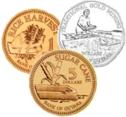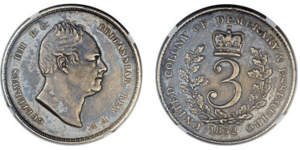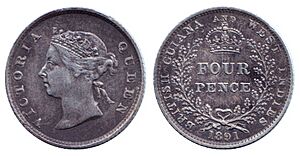Guyanese dollar facts for kids
Quick facts for kids Guyanese dollar |
|||||
|---|---|---|---|---|---|
|
|||||
| ISO 4217 Code | GYD | ||||
| User(s) | |||||
| Inflation | 5.8% | ||||
| Source | [1], 2022 | ||||
| Subunit | |||||
| 1⁄100 | cent | ||||
| Symbol | $, G$, GY$ | ||||
| Coins | $1, $5, $10 | ||||
| Banknotes | $20, $50, $100, $500, $1000, $2000, $5000 | ||||
The Guyanese dollar (symbol: $, G$ and GY$; ISO code: GYD) is the money used in Guyana. This country used to be called British Guiana. People have been using the Guyanese dollar since January 29, 1839.
It was first created to help change from the Dutch guilder money system to the British pound sterling system. The Spanish dollar was already common in the West Indies. So, from 1839, the Spanish dollar was used in British Guiana. It worked with British sterling coins. One dollar was worth four shillings and twopence.
In 1951, new decimal coins replaced the British sterling coins. These new coins were used across all British territories in the Eastern Caribbean. In the early 1970s, the British pound started to lose value. So, Guyana and other countries decided to link their money to the US dollar. This helped to control rising prices. The Eastern Caribbean Currency Authority made this change in October 1975. The Guyanese dollar is usually shown with the dollar sign $. Sometimes it's called G$ to show it's different from other dollar currencies.
Contents
How Did the Guyanese Dollar Start?
To understand the Guyanese dollar, we need to look at the history of money in the British West Indies. (You can also read about Currencies of the British West Indies). What makes British Guiana special is that it kept using the four pence groat coin. Other places stopped using it. Also, British Guiana used dollar accounts for money since 1839. In other Eastern Caribbean areas, they used a mix of dollar and sterling accounts until 1951.
From Dutch to British Control
The Dutch areas of Essequibo, Demerara, and Berbice were on the north coast of South America. They were created in the early 1600s. During the Napoleonic wars, the British took control of these areas. In 1815, these lands officially became part of the United Kingdom. They joined together to form the colony of British Guiana in 1831.
At first, the British brought in a British version of the Dutch guilder money. Then, in 1839, the Spanish dollar was introduced. This helped to bring in British sterling silver coins. Spanish silver dollars, also called pieces of eight, were already used a lot. They were common alongside Dutch coins and throughout the Eastern Caribbean. The dollar unit helped to convert money between sterling and the old guilder unit. One dollar was worth 4 shillings and 2 pence in British money. It replaced the guilder at a rate of 1 dollar for every 3 and 1/8 guilders. This meant £1 was equal to $4.80 or 15 guilders.
The Popular Groat Coin
A special thing about British silver coins in British Guiana was how popular the 4 pence coin was. This coin was known as the groat. It was popular because it was worth the same as the very common 'bit' coin. The 'bit' coin was one-quarter of a guilder.
The groat coin stopped being used in the United Kingdom in the late 1800s. But in 1888, a special request was made to make more groats for the British West Indies and British Guiana. These coins were first made in 1891. From 1917, they were made only for use in British Guiana. Spanish, Mexican, and Colombian silver dollars were used with British sterling coins until 1876. After that, these dollar coins were no longer valid money.
It's important not to mix up the Spanish dollar with the American dollar. The American dollar was first used in the US in 1792. Its value was based on the average weight of old Spanish dollars. Because of this, the American dollar was a little less valuable than the Spanish dollar.
Coins Used in Guyana
After the dollar was introduced, regular British coins were used. Also, 2 and 4 pence coins were made for British Guiana and other parts of the British West Indies. The 2 pence coins made in 1838, 1843, and 1848 were like the standard Maundy money coins. The 4 pence coins had an image of Britannia.
Between 1891 and 1916, 4 pence coins were made specifically for "British Guiana and West Indies." From 1917 to 1945, they were made for "British Guiana" only. In 1916, the Government of British Guiana also started printing paper money. These were in values of 1, 2, 5, 20, and 100 dollars.
Modern Guyanese Coins
In 1967, new coins were introduced. These were in values of 1, 5, 10, 25, and 50 cents. The 1 and 5 cent coins were made of Nickel-brass. The other coins were made of cupro-nickel. These coins stopped being valid money in 1992.
In 1996, prices rose a lot, so new 1, 5, and 10 dollar coins were made. The 1 and 5 dollar coins are made of copper-plated steel. The 10 dollar coin is made of nickel-plated steel. It has a unique equilateral-curved heptagonal (seven-sided) shape. In August 2020, a 100 dollar coin was launched. This coin is special because it's the first colored coin issued by the Bank of Guyana.
Banknotes (Paper Money)
Early Banknotes
Private banks started printing banknotes in the late 1800s. The British Guiana Bank and the Colonial Bank both issued 5, 20, and 100 dollar notes. The British Guiana Bank printed notes until 1907. The Colonial Bank printed notes until 1917. Barclays Bank took over the Colonial Bank. Barclays then issued notes in values of 5, 10, 20, and 100 dollars between 1926 and 1941.
In 1909, the Royal Bank of Canada started issuing 100 dollar notes. In 1913, they added 5 and 20 dollar notes. From 1920, these notes also showed their value in sterling. The 100 dollar notes were printed until 1920. The 5 and 20 dollar notes were printed until 1938.
Transition to Guyanese Dollar Notes
Paper money made specifically for British Guiana stopped in 1942. Local notes were replaced by BWI$ notes in 1951. In 1955, the BWI$ system changed to decimals. Coins were then issued in the name of the "British Caribbean Territories, Eastern Group."
In 1965, the East Caribbean dollar (EC$) replaced the BWI$. It was used in British Guiana for one year. After Guyana became independent in 1966, the Guyanese dollar was introduced. It replaced the East Caribbean dollar at the same value.
Modern Guyanese Banknotes
Banknotes were first issued on November 15, 1965. They came in values of 1, 5, 10, and 20 dollars. A second set of notes was issued between 1988 and 1992. These were 20, 100, and 500 dollar notes. The series from 1996 to 1999 included 20, 100, 500, and 1000 dollar notes. The 2000–2002 series had 500 and 1000 dollar notes.
New 100 and 1000 dollar banknotes were issued on March 29, 2006. The 100 dollar note looks similar to the one before it. But the numbers for the value are larger, and the background pattern is different. Both notes now have designs that go all the way to the edges. They also have watermarks that show a map of Guyana.
The 2011 notes included 500 and 1000 dollars. They have new security features. The most noticeable is a holographic stripe with a colorful macaw. This replaced the OVD patch used on older notes. On November 15, 2013, the Bank of Guyana showed the 5,000 dollar note. It was issued on December 9. As of now, there are no plans for a regular 10,000 dollar note for Guyana. In February 2022, the Bank of Guyana showed the 2,000 dollar note.
Special Commemorative Banknotes
Sometimes, special banknotes are made to celebrate important events.
- N.D. (2016) 50 Dollars - This note celebrated 50 Years of Independence for Guyana.
- N.D. (2021) 2,000 Dollars - This note celebrated 55 Years of Independence. It was released in late February 2022. This is also the first polymer banknote for Guyana, meaning it's made of a special plastic material.
| Current GYD exchange rates | |
|---|---|
| From Google Finance: | AUD CAD CHF EUR GBP HKD JPY USD JPY USD |
| From Yahoo! Finance: | AUD CAD CHF EUR GBP HKD JPY USD JPY USD |
| From XE.com: | AUD CAD CHF EUR GBP HKD JPY USD JPY USD |
| From OANDA: | AUD CAD CHF EUR GBP HKD JPY USD JPY USD |
| From fxtop.com: | AUD CAD CHF EUR GBP HKD JPY USD JPY USD |
See also
- Economy of Guyana
- Surinamese dollar
Images for kids







